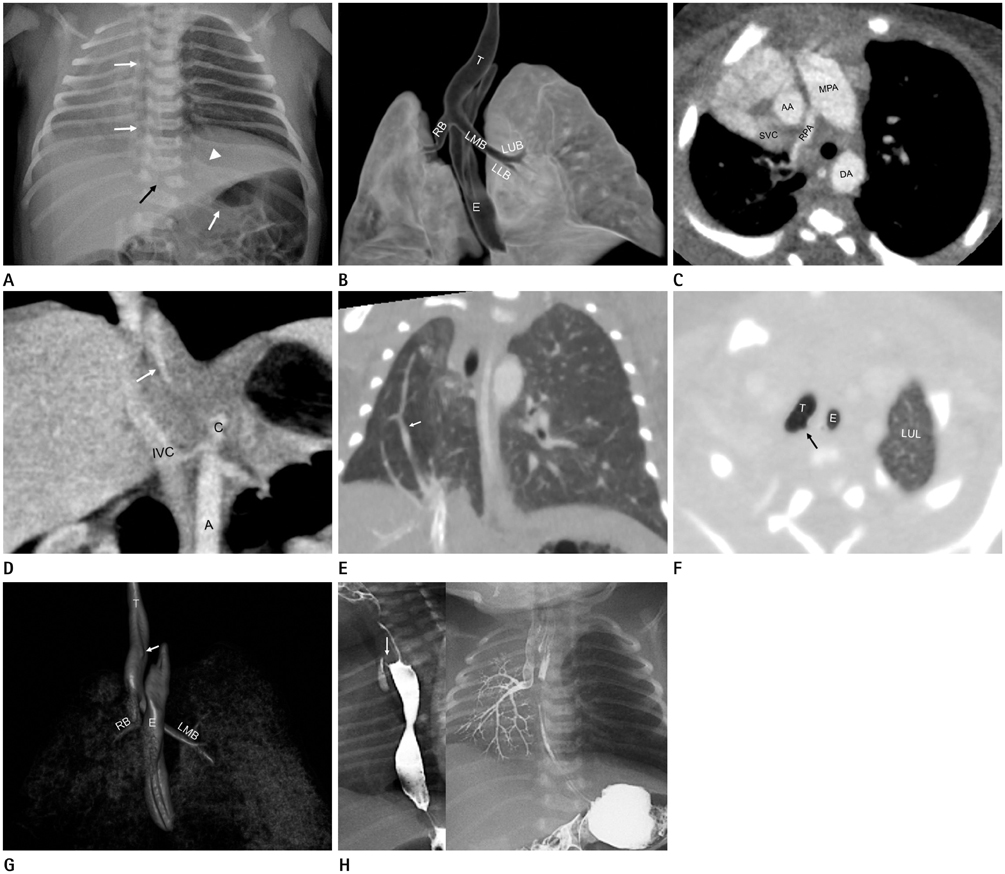J Korean Soc Radiol.
2014 Oct;71(4):191-195. 10.3348/jksr.2014.71.4.191.
A Case of Scimitar Syndrome with H-Type Tracheoesophageal Fistula and Multiple Anomalies: Diagnosis Using Electrocardiography-Gated Chest CT
- Affiliations
-
- 1Department of Radiology, Dong-A University Hospital, Dong-A University College of Medicine, Busan, Korea. medcarrot@dau.ac.kr
- KMID: 2098005
- DOI: http://doi.org/10.3348/jksr.2014.71.4.191
Abstract
- Scimitar syndrome is a rare, combined abnormality of bronchopulmonary development and pulmonary vascular development characterized by an anomalous pulmonary venous return to the inferior vena cava. Although the scimitar syndrome has been associated with many anomalies, a tracheoesophageal fistula (TEF), especially from H-type, is extremely rare and only a few cases have been reported without detailed descriptions. Herein we report a rare case of scimitar syndrome with H-type TEF and multiple anomalies in a newborn infant, with a special emphasis on the imaging features associated with the radiologic diagnosis using an electrocardiography-gated computed tomography.
MeSH Terms
Figure
Reference
-
1. Neill CA, Ferencz C, Sabiston DC, Sheldon H. The familial occurrence of hypoplastic right lung with systemic arterial supply and venous drainage "scimitar syndrome". Bull Johns Hopkins Hosp. 1960; 107:1–21.2. Najm HK, Williams WG, Coles JG, Rebeyka IM, Freedom RM. Scimitar syndrome: twenty years' experience and results of repair. J Thorac Cardiovasc Surg. 1996; 112:1161–1168. discussion 1168-1169.3. Khalilzadeh S, Hassanzad M, Khodayari AA. Scimitar syndrome. Arch Iran Med. 2009; 12:79–81.4. Ahamed MF, Al Hameed F. Hypogenetic lung syndrome in an adolescent: imaging findings with short review. Ann Thorac Med. 2008; 3:60–63.5. Huddleston CB, Mendeloff EN. Scimitar syndrome. Adv Card Surg. 1999; 11:161–178.6. Clark DC. Esophageal atresia and tracheoesophageal fistula. Am Fam Physician. 1999; 59:910–916. 919–920.7. de Jong EM, Felix JF, de Klein A, Tibboel D. Etiology of esophageal atresia and tracheoesophageal fistula: "mind the gap". Curr Gastroenterol Rep. 2010; 12:215–222.8. Lastinger A, El Yaman M, Gustafson R, Yossuck P. Scimitar Syndrome and H-type Tracheo-esophageal Fistula in a Newborn Infant. Pediatr Neonatol. 2013; pii: S1875-9572(13)00154-X.9. Legras A, Guinet C, Alifano M, Lepilliez A, Régnard JF. A case of variant scimitar syndrome. Chest. 2012; 142:1039–1041.10. Podberesky DJ, Angel E, Yoshizumi TT, Toncheva G, Salisbury SR, Alsip C, et al. Radiation dose estimation for prospective and retrospective ECG-gated cardiac CT angiography in infants and small children using a 320-MDCT volume scanner. AJR Am J Roentgenol. 2012; 199:1129–1135.
- Full Text Links
- Actions
-
Cited
- CITED
-
- Close
- Share
- Similar articles
-
- Espihageal Atresia with Tracheoesophageal Fistula and Other Multiple Congenital Anomalies: An autopsy case
- A Case of the Esophageal Atresia with Distal Tracheoesophageal Fistula Associated with Duodenal Obstrction
- A case of agenesis of the right lung with H-type tracheoesophageal fistula
- Acquired Tracheoesophageal Fistula through Esophageal Diverticulum in Patient Who Had a Prolonged Tracheostomy Tube: A Case Report
- Adult Tracheoesophageal Fistula Incidentally Found on General Endotracheal Anesthesia: A Case Report


